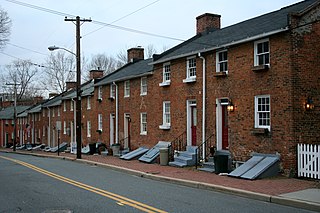
Oella is a mill town on the Patapsco River in western Baltimore County, Maryland, United States, located between Catonsville and Ellicott City. It is a 19th-century village of millworkers' homes.
West Nottingham Academy is an independent co-ed school serves both boarding and day students in grades 9-12. It was founded in 1744 by the Presbyterian preacher Samuel Finley, who later became President of The College of New Jersey. The 124-acre (0.50 km2), tree-lined campus is located in Colora, Cecil County, Maryland near the Chesapeake Bay – an hour and a half south of Philadelphia and twenty minutes north of Baltimore.

St. Ignatius Church is a Roman Catholic parish church of the Archdiocese of Washington located at 2315 Brinkley Rd., Fort Washington, MD 20744, in Oxon Hill, Prince George's County, Maryland. The historic church structure was constructed between 1890 and 1891. The 1+1⁄2-story structure is wood frame, with clapboarding, and shingling in imbricated pattern. It is rectangular in form with a gabled roof, 80-foot (24 m) projecting front belfry with spire and louvered openings, round arched openings, and modified corner buttresses. The architectural style is considered Eclectic, with elements of the Shingle and Queen Anne styles. It is the second church on site and has served as a mission and parish church. The original church, built in 1849, was partially funded by Mary Surratt, one of the conspirators involved with the Assassination of Abraham Lincoln.

St. Mary's Beneficial Society Hall, constructed in 1892, is a historic building located in Upper Marlboro, Prince George's County, Maryland.

The Third Addition to Rockville and Old St. Mary's Church and Cemetery is a historic area located in Rockville, Montgomery County, Maryland. This area combines 19th century residential scale buildings with a tree-lined narrow street, country church, weathered headstones, Victorian Gothic railroad station, and a brick cast-iron front commercial structure, to create an atmosphere that evokes the era when the station served as the gateway to Rockville. In addition to Victorian Gothic, architectural styles used in residential buildings include Queen Anne, Georgian, and Colonial Revival. The area was listed on the National Register of Historic Places in 1978.
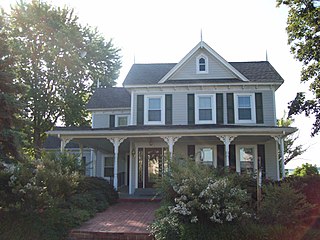
Abell House is a historic home located at Leonardtown, St. Mary's County, Maryland, United States. It was constructed about 1910 and is a two-story, three bay frame dwelling. The house commands sweeping views of Breton Bay, a sheltered harbor of the Potomac River. It exhibits a vernacular interpretation of the Queen Anne. It was built by Enoch B. Abell, a significant local political leader, attorney, and entrepreneur, who resided there until his death in December 1924.
Buena Vista, or Bard's Field on Trinity Manor, is a historic home located at Leonardtown, St. Mary's County, Maryland, United States. It is a 2+1⁄2-story, three-bay, Greek Revival-style frame dwelling with a 2-story, three-bay, frame, wing. It was built between 1840 and 1850, for George and Mary C. Combs.
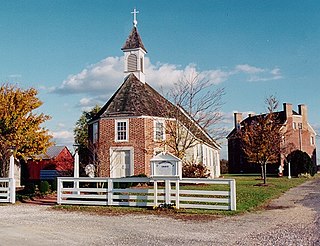
St. Francis Xavier Church and Newtown Manor House Historic District is the first county-designated historic district in Saint Mary's County, the "Mother County" of Maryland and is located in Compton, Maryland, near the county seat of Leonardtown. The district marks a location and site important in the 17th-century ecclesiastical history of Maryland, as an example of a self-contained Jesuit community made self-supporting by the surrounding 700-acre (2.8 km2) farm. The two principal historic structures were added to the National Register of Historic Places in 1972. Archaeological remains associated with the site date back to the early colonial period, mid-17th century.

The Inns on the National Road is a national historic district near Cumberland, Allegany County, Maryland. It originally consisted of 11 Maryland inns on the National Road and located in Allegany and Garrett counties. Those that remain stand as the physical remains of the almost-legendary hospitality offered on this well-traveled route to the west.

Stanton's Mill is a historic grist mill complex located at Grantsville, Garrett County, Maryland, consisting of five interrelated buildings and structures. The Stanton's Mill building dates from about 1797. It is two stories and constructed of heavy timber frame with a gable roof; an addition was constructed in 1890. The complex includes a stone-faced, mid-19th-century timber crib dam and raceway, natural earthen tailrace, and a small, single-span stone arch bridge, dating to 1813, constructed as part of the National Road. Also on the property is a frame storage building, constructed about 1900.
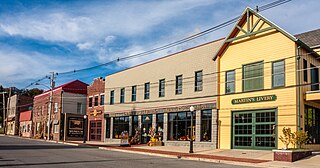
Oakland Historic District is a national historic district in Oakland, Garrett County, Maryland. It is an L-shaped area in the central and older section of Oakland containing 206 buildings. They reflect the evolution of this rural county seat from the mid-19th to mid-20th centuries. It includes the Garrett County Courthouse, but the majority of the buildings are residential of frame construction and positioned with deep setbacks from the street, surrounded by large lawns. Several churches and schools and a library are scattered in the district.

The McKinstry's Mills Historic District is a national historic district in Union Bridge, located in Carroll and Frederick County, Maryland. The district comprises the entirety of the settlement of McKinstry's Mills, a 26-acre (110,000 m2) hamlet consisting of six separate properties that were owned and developed in the 19th century by the McKinstry family, local millers. At the center is a 3+1⁄2-story grist mill constructed in 1844. Also included are the McKinstry homestead, built between 1825 and 1835; the residence of miller Samuel McKinstry, dated 1849; a store building of 1850; and two other small houses and a variety of outbuildings. There is also a 1908 Warren pony truss bridge.

The Edward W. Haviland House is a historic home located at Port Deposit, Cecil County, Maryland, United States. It is a 2+1⁄2-story, 12-room, stuccoed frame building constructed in 1913 in the Dutch Colonial style. In 1926, a large frame double garage and carriage house was built to the rear of the main house. The house was designed by architect Charles J. McDowell.
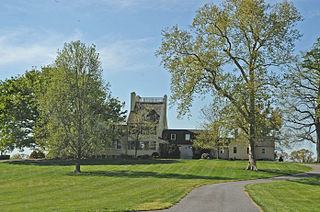
Rose Hill, also known as Chance and Wheeler Point, is a historic home located at Earleville, Cecil County, Maryland, United States. It is the product of four major building periods: a gambrel-roofed frame structure built at the end of the 18th or beginning of the 19th century; a 2+1⁄2-story brick "town house" constructed on the east in 1837; and a small frame kitchen and a one-story wing built in the 1960s. Also on the property are a smokehouse, ice house, and shed. The garden includes two of the largest yew trees living in the United States. It was the home of General Thomas Marsh Forman (1756–1845), who served as a young man in the American Revolutionary War.

Woodlands is a historic home located at Perryville, Cecil County, Maryland, United States. It appears to have been constructed in two principal periods: the original 2+1⁄2-story section built between 1810 and 1820 of stuccoed stone and a 1+1⁄2-story rear kitchen wing; and two bays of stuccoed brick, with double parlors on the first story, and a one-story, glazed conservatory constructed between 1840 and 1850. The home features Greek Revival details. Also on the property are a 2-story stone smokehouse and tenant house, a small frame barn and corn house, a square frame privy with pyramidal roof, a carriage house, frame garage, and a large frame bank barn.

St. Francis Xavier Church, or Old Bohemia, is a historic Roman Catholic church located at Warwick, Cecil County, Maryland, United States. It is located on what was once the Jesuit estate known as Bohemia Manor.

Creagerstown is an unincorporated community in Frederick County, Maryland, United States. It is playfully known by its residents as "4 miles from everywhere" because of its situation at 4 miles (6.4 km) from Thurmont, Woodsboro, Rocky Ridge, and Lewistown.

Whitaker's Mill Historic District is a national historic district near Joppa, Harford County, Maryland, United States. It includes three early- to mid-19th-century buildings: the 2+1⁄2-story rubble stone Whitaker's Mill built in 1851, the 1+1⁄2-story rubble stone miller's house, and the log-and-frame Magness House, begun about 1800 as the miller's house for the first mill on the site. The district also includes an iron truss bridge known as Harford County Bridge No. 51, constructed in 1878, and the oldest such span in the county. The grist mill closed operations about 1900.

Jeremiah Brown House and Mill Site is a Colonial-era mill complex and national historic district at Rising Sun, Cecil County, Maryland, United States. It consists of two distinct halves: a two-story, three-bay, gable-roofed stone structure built in 1757 by Jeremiah Brown, Sr., a Quaker from Pennsylvania; and a two-story, two-bay gable-roofed frame house built in 1904 by John Clayton on the site of the original 1702 log wing. Also on the property is a small 19th century bank barn; a reconstruction of the original mill built on top of the stone foundations of the 1734 Brown Water Corn and Gristmill; and the foundations of an 18th-century saw mill.

Lehman's Mill Historic District is a national historic district at Hagerstown, Washington County, Maryland, United States. The district comprises the remaining buildings of the mill group including the brick Lehman's Mill, built in 1869 for Henry F. Lehman, the farmstead with a stuccoed stone house dated 1837 with older and newer sections, a barn, carriage house, and agricultural outbuildings; another dwelling, also built by Lehman in 1877, a two-story brick and frame house; related outbuildings, and a portion of the mill's head and tail race. It is the oldest continuously operating mill in Washington County, and is the most intact mill complex remaining in the county.
























